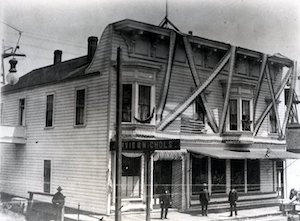
Photograph of the Jarvis & Nichols Building, located on the north side of Main Street in Mendocino. It has been exuberantly draped with bunting and decorated with flags for the July 4th, 1907 Parade and Celebration. The view is looking to the northeast and is taken from the second floor of the Meat Market on the south side of Main Street. Four men in hats appear in the picture, along with two horses at a hitching post and a water trough. A striped canvas awning is furled on the west side of the store, while a rigid canopy shades the windows on the east side.
Jarvis & Nichols’ general merchandise store occupied the first floor of this elegant building until 1914, when they sold the property to their former clerk, Burtt Elliott. He had lived upstairs as a boy with his mother, America Jane Elliott, who also conducted a dressmaking business there at one time. The west dwelling was accessed by the “flying staircase” partially seen on the left, and the east one had its front door on the far right of the building. Designed by L. A. Morgan and built in 1874, this is actually two separate structures that share a common interior wall (later removed), and are united by an ornate false front with bay windows.
Two water towers are visible in the background. The one on the left was built in 1879 by Jarvis & Nichols and was replaced in 1924 by Mr. Elliott. The tank tower on the right was built in December of 1906. The windmill seen here was replaced in September of 1907 with a gasoline-powered pump by property owner A. F. Luiz (Luis). At this time, the Luis family operated a clothing and general merchandise store (only partially visible here) in this Main Street building, which in later years would house the Remedy Store and Highlight Gallery. They would add a second story to the building in 1908.
An electric light is hanging over the street, anchored and powered by wires attached to the square pole set at the corner of Main and Kasten Streets. Mendocino first got electricity in 1902 via a steam-powered generating plant located on Big River flat that utilized waste wood from the lumber mill.
The presence of the board sidewalk in front of the store confirms that this photograph was taken before Gus Johnson laid 310 feet of cement sidewalk from the Jarvis & Nichols store eastward to the east line of Dr. Peirsol’s drug store (later known as the The Music Box), as reported in the Mendocino Beacon of November 9, 1907.
Early Mendocino Coast by Katy Tahja – From the Sonoma County line to the Humboldt County line a century ago. A tribute to the creativity and perseverance of the common working man. Images of America series. $22.